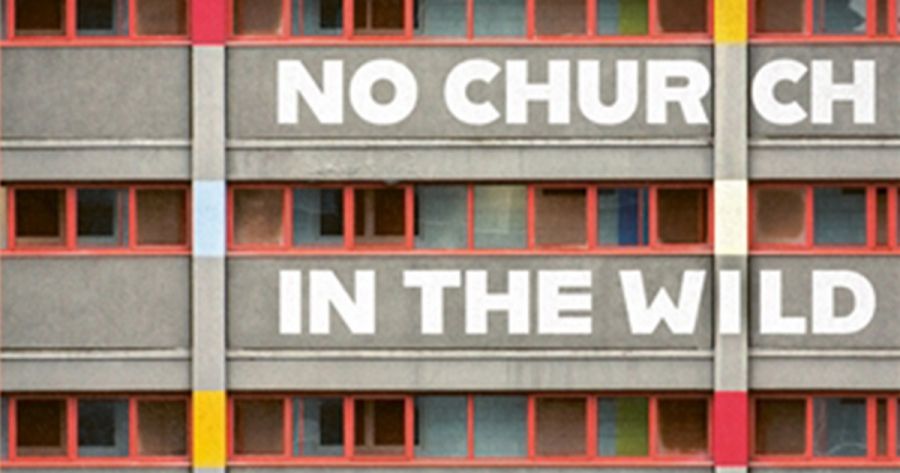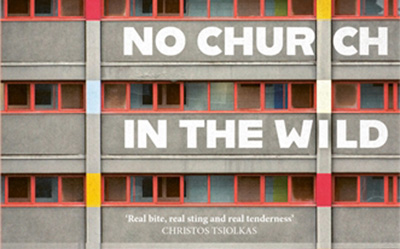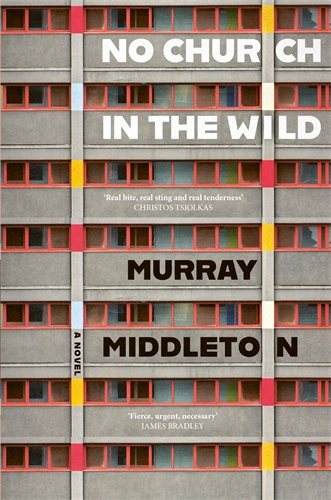
- Free Article: No
- Contents Category: Fiction
- Review Article: Yes
- Article Title: ‘We live here’
- Article Subtitle: Murray Middleton’s début novel
- Online Only: No
- Custom Highlight Text:
Murray Middleton’s début novel, No Church in the Wild, opens beneath Flemington’s public housing towers in inner-city Melbourne. Residents of the towers flood the street to witness the police arrest a group of children ‘pinned on the concrete, knees digging into their spines’. One of these observers is Ali, a grade six primary school student. Ali recognises a Somali friend of his, Walid, as one of the boys under arrest. From Ali’s perspective, it is the latest provocation in a months-long campaign of police harassment against the local African migrant community. When things escalate and police direct the observers to leave, Ali responds: ‘Why should we? ... We live here.’ As the first of five parts, this opening scene is prologue to the action of the novel, which takes place five years later as Ali and Walid embark on their final years of schooling amid a community still suffering from problematic police interactions.
- Featured Image (400px * 250px):

- Alt Tag (Featured Image): Morgan Nunan reviews ‘No Church in the Wild’ by Murray Middleton
- Book 1 Title: No Church in the Wild
- Book 1 Biblio: Picador, $34.99 pb, 384 pp
- Book 1 Cover Small (400 x 600):

- Book 1 Cover (800 x 1200):

In an attempt to repair the ‘[l]ong-term disengagement with local youth’, police invite high-school students to join a training program that will culminate in a trip to Papua New Guinea to hike the Kokoda Trail. This program becomes the central device that unites four of the chief characters of the novel: Ali; his classmate and occasional antagonist, Tyler; their teacher, Anna; and police officer Paul. Using subheadings to signal shifts in perspective between these characters, Middleton mostly pairs two episodic, character-focalised sections per chapter, plotted across a roughly overlapping temporal period; a structure (and prose style) similar to that previously utilised by Middleton in his short story ‘Burnt Hill Farm’ from his collection When There’s Nowhere Else to Run (2015). Extended to the novel format, the result is a rich multiplicity of voices (aided by Middleton’s ear for the unique rhythms of teenspeak, best showcased when characters are contained in classrooms or KFC) and a mostly energetic narrative pacing, allowing for a layered rendering of setting and character.
Although Ali’s perspective recurs most frequently, his role is more often that of an observer, especially of Walid, who is now involved in a long-running civil claim against Victoria Police. As Walid tells Ali, the legal proceeding, which relates to the action of the prologue, is about ‘bigger things’ than monetary compensation. It also offers a stage for truth-telling and police accountability, acting as a counterbalance to the police-driven Kokoda program and other self-serving initiatives and investigations that have failed to build trust with the community. Walid acts as moral guide to Ali. His commitment to the case, his disciplined attention to his education and religion, his ambition to attend the University of Melbourne, and his retreat from anything crime-related place him at odds (even in conflict) with some of his classmates. By comparison, Ali’s engagement with hip-hop culture (he dreams of becoming a Billboard Hot 100 artist) includes tagging his MC name across Flemington. He also flirts (mildly) with the drug culture that surrounds them and is more at ease with increasingly hardened classmates, though he keeps half an eye on Walid and his education.
Tyler’s cynicism towards his teachers (‘… they don’t really give a shit, and neither does he’), his education (‘[students are just] passing time until they don’t have to be at this povo school anymore’), Walid, and the rest of his classmates (‘He’s just going to end up unemployed and addicted to meth, like every other deadshit from the flats’) speaks to his isolation. Tyler’s mother is severely drug addicted; his father incarcerated. He is self-conscious about his poor personal hygiene, and most days he goes hungry. His overt racism, shaved head, and violent fantasies position him as a neo-Nazi in the making (à la Romper Stomper, a connection Paul makes upon observing him), yet there is a sense that his offensive views have not yet crystallised. Though overlooked by most (Anna is one exception), Tyler’s actions often belie his unpleasant remarks. In these sections, Middleton’s use of free-indirect style is at its strongest. The unreliability of Tyler’s implied interior betrays how deeply his defence mechanisms are rooted, yet it is through Tyler that Middleton best illustrates the significance of hope (its presence or absence; its precarity) for characters living on the margins.
This theme, along with some of the character dynamics, the use of the child perspective, and the inner-city suburban Melbourne setting, bear similarities to works like Tony Birch’s Ghost River (2015), although Middleton sets his novel closer to the present, a near-contemporary pre-Covid Australia. Aside from a few brief excursions (including the trip to Kokoda), the novel’s central setting is Melbourne’s inner-west. Initially moving to Melbourne from the country, Anna now finds herself living alone in Kensington following an unexpected break-up. Similarly, Paul has transferred from another district with ambitions to climb the police ranks. The relative ease with which both characters move in and out of the inner-west is contrasted with Ali and his classmates, who are much more tethered to the public housing estates they call home. This tension gives rise to a complex spectrum of feelings about place, ranging from pride to revulsion. Early in the novel, Ali takes in the outlook from a Flemington high-rise building, admiring ‘the best view in the city’. Later, Tyler is mystified by the ongoing gentrification in the area: ‘If Tyler were loaded, this’d be the last place in the world he’d live.’
The final part of the book comprises one chapter within which Middleton elects to escalate his structure by including eleven short fragments, shifting between character perspectives several times. The acceleration in pace suits the increasing tension of Tyler’s narrative (and its progression towards a menacing climax), though it does leave the resolution to other threads feeling slightly rushed. Nonetheless, this is a highly affecting and stylistically engaging novel. With his move to the long form, Middleton’s writing remains daring and ever humane.


Comments powered by CComment